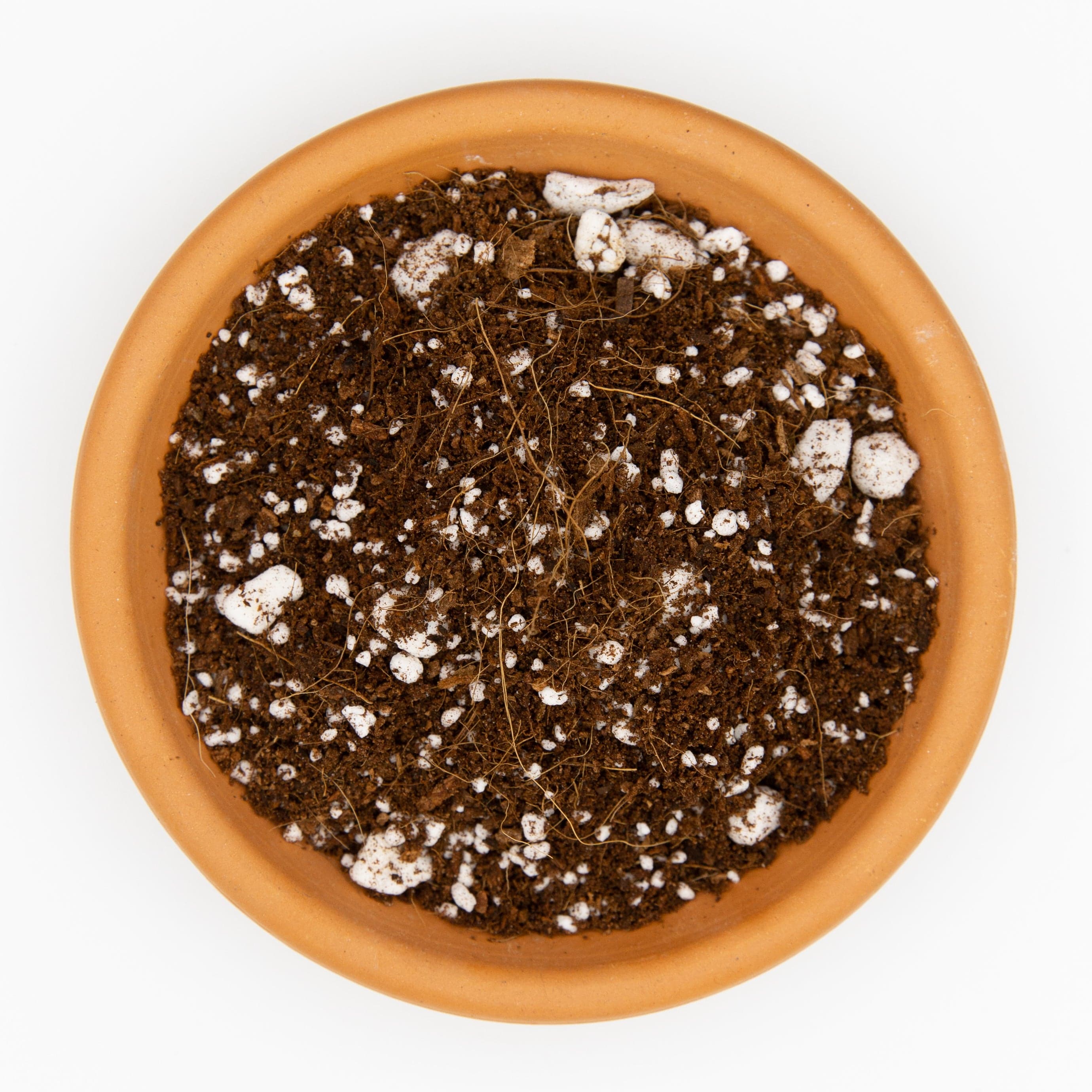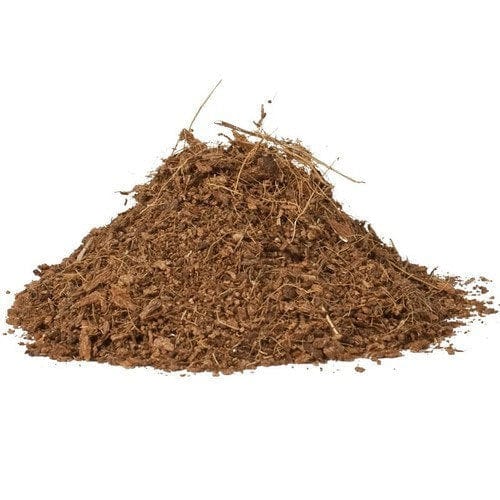The hydroponic gardener's preferred blend for premium Hydroponic grade use is Coco Coir (also known as coco peat) & Perlite at a ratio of 70/30.
Coco coir is known worldwide as Coco Coir Peat, Coco Coir Pith, or Coco Coir Fibre. It is a 100% renewable resource and completely sustainable for production.
Washed + Buffered to a low EC level. Perfect for hydroponic use or building living soils with the addition of organic matter.
-
Breathing Room: With the perfect balance of air and water retention, this 70:30 mix promotes healthy root growth while preventing waterlogging.
-
Drain, Drain, Drain: Perlite's addition to the mix enhances drainage, preventing water buildup and promoting healthy plant growth.
-
Moisture Magic: The 70:30 mix helps maintain consistent moisture levels, giving your plants a stable environment to grow and thrive.
-
Nutrient Nirvana: This balanced mix promotes the uptake of nutrients by the plant roots, leading to stronger, healthier growth.
-
Root Revolution: With a mix that promotes the development of a strong and extensive root system, your plants will absorb water and nutrients with ease, leading to unbeatable growth.
Coco coir and its fibers are also often used to plant indoor house plants because it will hold moisture and the perfect air to avoid root rot!
- Coco Coir & Perlite both have a Neutral pH which is better for plants
- Coco Coir is a readily renewable resource
- Promotes moisture-holding capability of soil with less water
- Cation exchange capacity will be higher with the addition of coco coir.
FAQs:
What exactly is Coco Coir + Perlite 70/30?
A ready-to-use, soilless mix made from 70% coco coir (coconut husk fibre/pith) and 30% perlite. It’s washed and buffered to a low EC, giving you a clean, airy, free-draining medium that roots love.
Is the Coco Coir + Perlite 70/30 mix washed and buffered, or do I need to rinse it first?
It’s already washed and buffered to a low EC. You don’t need to pre-rinse salts out. Just pre-wet it with your nutrient solution before planting so it’s evenly moist.
What does “buffered” actually mean?
Buffering pre-loads the coco’s exchange sites (the bits that hold nutrients) so they don’t steal calcium/magnesium from your feed. Result: fewer early-stage deficiencies and a smoother start.
Does the Coco Coir + Perlite 70/30 contain any fertiliser?
Nope. It’s an inert medium. Feed from day one with your nutrient solution (we recommend a gentle seedling rate to start).
What pH should I use with coco/perlite?
Aim for 5.8–6.2 going in (irrigation solution). That’s the sweet spot for nutrient availability in coco.
Do I still need Cal-Mag if it’s buffered?
Usually, yes—especially if you use RO/soft water or heavy-feeding crops. Add a modest Cal-Mag dose to your regular feed; you don’t need to go crazy, just keep it consistent.
Is Coco Coir + Perlite 70/30 good for houseplants and tropicals?
100%. The extra perlite keeps things airy so you get moisture without the swamp—great insurance against root rot for aroids, philodendron, monstera, etc.
Can I use Coco Coir + Perlite 70/30 for hydroponic grows?
Yes—this is a hydroponic-grade coco mix. Treat it like a coco hydro system: feed lightly but often, and aim for some runoff.
How often should I water?
Keep coco evenly moist—never bone dry. Seedlings: small, frequent feeds. Established plants: once to several times per day depending on pot size, plant size, light/temps, and airflow. Let your runoff and plant behaviour be the guide.
How much runoff should I target?
About 10–20% per irrigation once plants are established. It helps prevent salt build-up and keeps EC stable.
What EC/PPM should I feed?
As a rough, safe starting point: seedlings 0.6–1.0 mS/cm, veg 1.2–1.6, bloom 1.6–2.0—always adjust to the plant and measure runoff EC to steer.
Does coco/perlite “overwater” like soil can?
Properly managed coco stays oxygenated even when wet, so the classic soil over-watering issues are much less likely. Problems happen when coco dries out fully or salts build up—avoid both.
What pot sizes work best?
Everything from solo cups to big fabric pots works. Smaller pots = more frequent feeds and faster growth; larger pots = a bit more buffer, fewer daily feeds.
Is the pH “neutral”?
Coco and perlite themselves sit close to neutral, but you should still feed at 5.8–6.2. “Neutral medium” doesn’t mean “neutral feed.”
Can I mix the Coco Coir + Perlite 70/30 into soil or other media?
Yep. Blend into soil to improve drainage and aeration, or add bark for an aroid mix. It plays nicely with most amendments.
Can I build a living soil with the Coco Coir + Perlite 70/30 mix?
You can. Add high-quality compost, worm castings, and balanced dry amendments, then let it cycle. You’ll get coco’s structure with organic nutrition.
Is Coco Coir + Perlite safe for edibles and herbs?
Yes. Coco/perlite is inert and safe for veggies, herbs, and fruiting plants—just feed appropriately.
Will Coco Coir + Perlite 70/30 mix help with fungus gnat issues?
It won’t magically prevent them (they love moisture), but the fast drainage helps. Let the top centimetre dry slightly between feeds, use sticky traps, and consider a biological control if needed.
What’s in the bag—chunks or fine pith?
A coco blend formulated for container growing with perlite for extra air space. It’s not a mulch; it’s a potting-grade medium.
Is perlite dusty?
It can be. Minimises dust by pre-wetting as you fill pots and avoid breathing the dry dust.
Do I need to add extra perlite?
70/30 is the standard “sweet spot” for high-oxygen coco grows. If your space runs very cool/dry, you can drop to ~60/40 (less perlite). If it’s hot/humid, some growers push to ~50/50 for even more drainage.
How do I prep the Coco Coir + Perlite 70/30 mix before planting?
Fill pots, lightly tamp, pre-wet with a mild nutrient/Cal-Mag solution to a little runoff, then transplant or sow.
Can I top-dress dry amendments on coco/perlite?
Yes. Scratch in gently and water in. If you’re running salts (hydro nutrients), keep top-dress rates modest and monitor EC.
How do I tell if salts are building up?
Rising runoff EC and tip burn are classic tells. Increase runoff volume, reduce feed strength slightly, or do a light flush, then resume normal fertigation.
Can I reuse coco/perlite?
You can, if you’re willing to do hygiene: remove roots, flush to low EC, optionally run an enzyme or mild peroxide flush, then re-buffer with a Cal-Mag solution before replanting.
Does Coco Coir + Perlite 70/30 mix compact over time?
Coco holds structure well but will settle a bit. A light top-up between cycles is normal.
Is Coco Coir + Perlite 70/30 mix peat-free and sustainable?
Yes—coco is a renewable by-product of the coconut industry, and perlite is an expanded volcanic glass.
Will Coco Coir + Perlite 70/30 mix work in self-watering pots or autopots?
Yes. Many growers run 70/30 in bottom-fed systems. Keep the wicking “root zone” moist and avoid letting the reservoir run dry.
What about drip systems?
Perfect match. Use simple stakes/rings, aim for consistent pulses with some runoff each day, and keep lines clean.
Can I use organic nutrients with Coco Coir + Perlite 70/30 mix?
Yes—mineral salts or organics both work. With organics, keep temps/oxygen good to avoid funk. With salts, monitor EC and runoff.
What about seedlings—too hot or too airy?
It’s fine. Pre-wet evenly, plant shallow, and feed gently. If you want extra moisture for babies, set a humidity dome or water a wider ring away from the stem.
How do I avoid nutrient lockout in coco?
Keep pH 5.8–6.2, don’t let the medium fully dry, feed little and often, and maintain that 10–20% runoff.
Will Coco Coir + Perlite 70/30 help prevent root rot?
The aeration helps a lot. Combine it with sensible watering and good airflow and you’re in a safe zone.
How much area does a 20 L bag cover?
Volume-wise: one 20 L pot, two 10 L pots, or roughly four 5 L pots. (Actual fill varies with how firmly you pack it.)
Is there a “break-in” period?
Not really—just pre-wet and plant. If you’re cautious, run the first week at lighter EC while roots colonise.
Any transplant tips?
Water both the old rootball and the new coco/perlite before transplanting, keep the crown at the same height, and water to runoff immediately after.
How should I store unopened bags?
Cool, dry place, out of sun. If a bag gets wet in storage, use it soon and check for off smells before potting.
Can I add microbes/mycorrhizae?
Absolutely. Inoculants pair well with coco/perlite—dust roots at transplant or water in per label.
What if my water is very hard/alkaline?
Consider a small RO unit or adjust feed pH carefully. Hard water can supply some Ca/Mg, so you may reduce Cal-Mag slightly—watch the plants and runoff EC/pH.
Is Coco Coir + Perlite 70/30 mix OK outdoors?
Yes. Great in containers or raised beds. Just recognise coco drains fast—hot, windy weather may mean more frequent watering.
Any compatibility gotchas?
Avoid mixing with heavy clay soils (it defeats the drainage benefits) and don’t alternate plain water and strong feed randomly—coco prefers consistent, balanced fertigation.
What signs tell me I nailed it?
White, fast-branching roots, steady new growth, leaves praying to the light, and stable runoff EC/pH. If you see that, keep doing exactly what you’re doing.
Click Here to view our huge range of hydroponic growing nutrients, which are perfect for coco coir + perlite cultivation!
Click Here to purchase a compressed coco coir block that will expand to 60L with added water.
Click Here to Purchase Perlite in various-sized bags.




